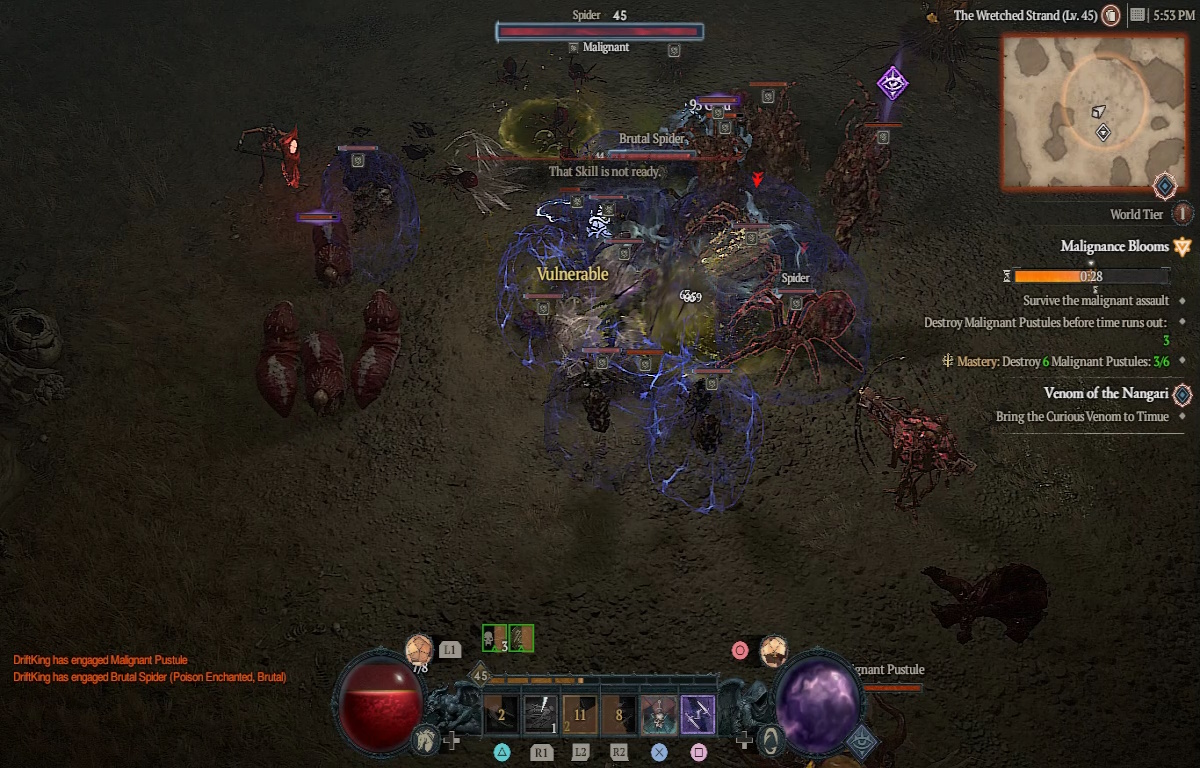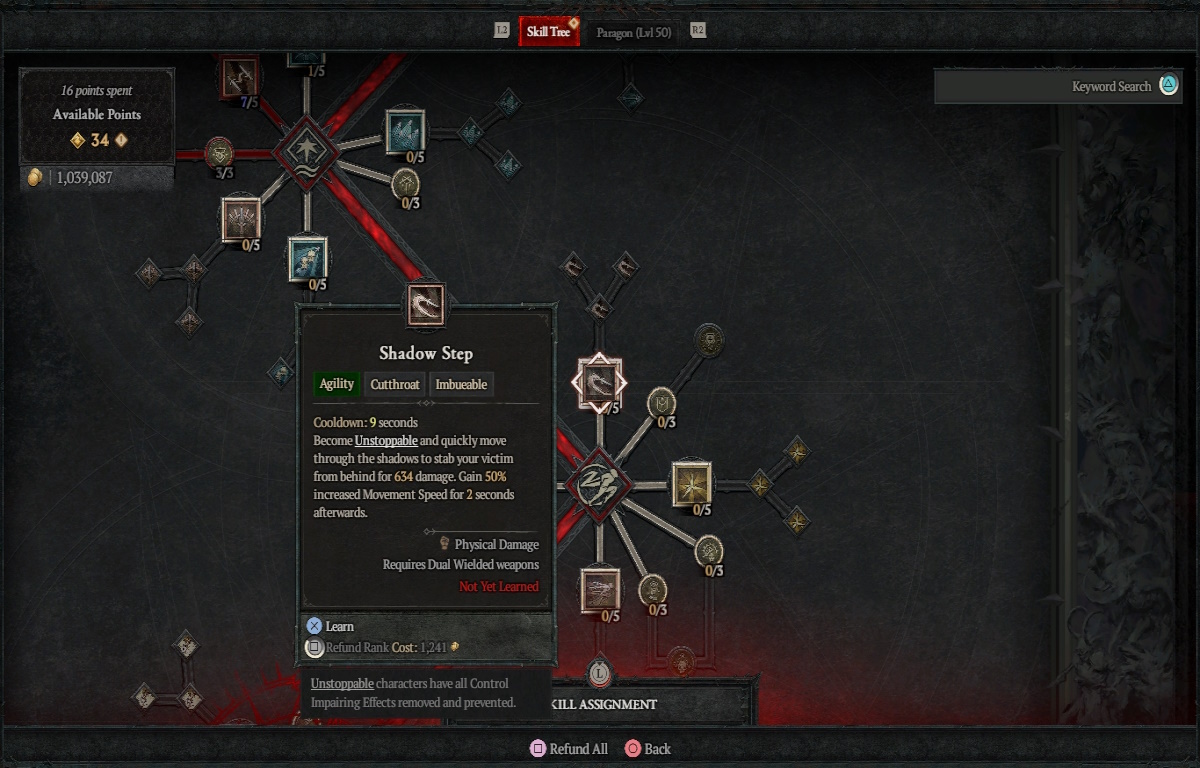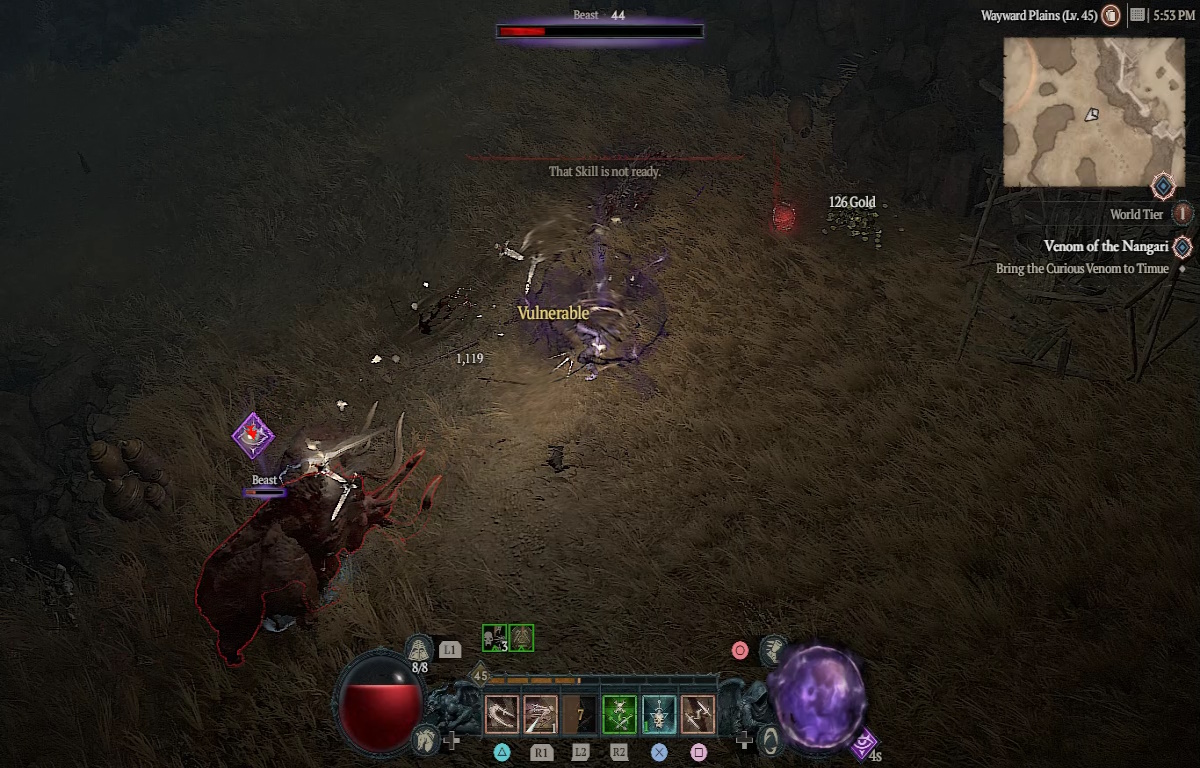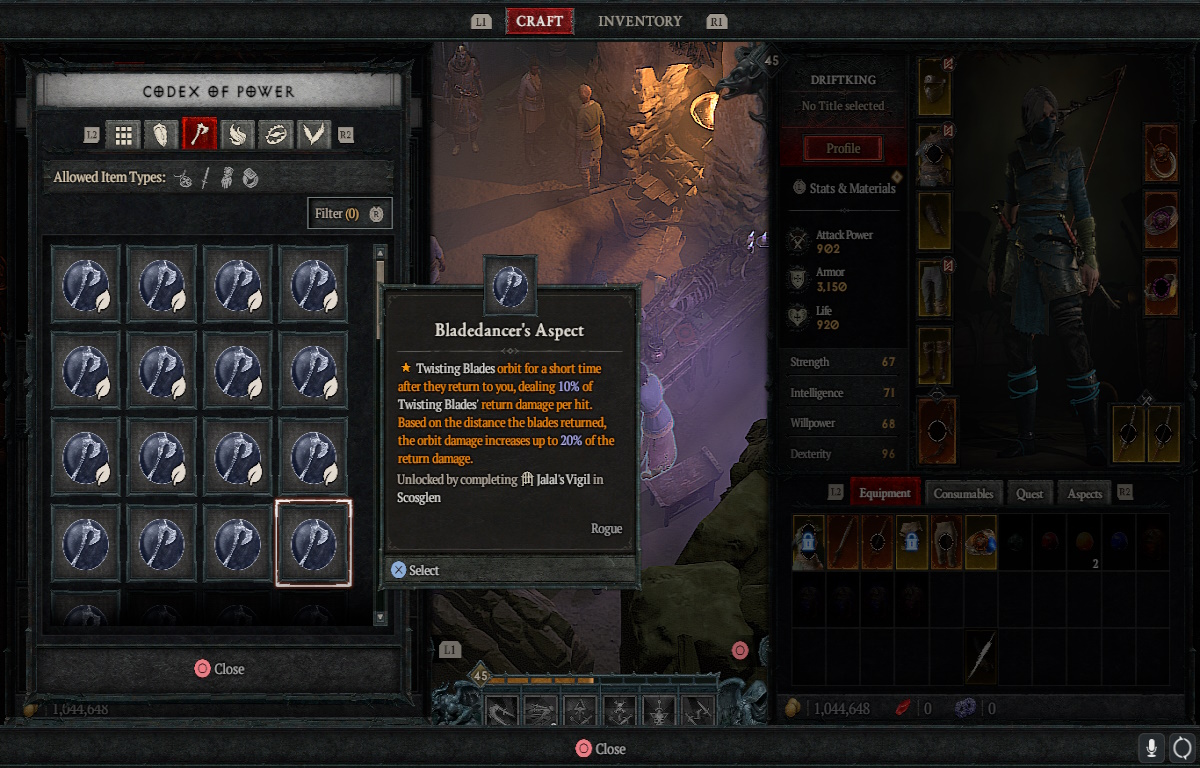Rogue is one of the strongest classes in the game right now and escaped the Season one nerfs with a minor slap on the wrist. The reduction to damage types like ‘Vulnerable’ certainly hurt, but that pain is shared across the entire roster. If you want to play a powerful character that requires a fair bit of skill, the Rogue offers exactly that. Your damage output is second to none if you can stay alive. Let me show you everything in our Diablo 4 Season 1 best Rogue endgame builds | Twisting Blades.
What is the best ‘Rogue Class’ endgame build in Diablo 4 Season 1?
Many pros and content creators predicted that Twisting Blades would be one of the most powerful builds in the game for the Season of the Malignant. Now the Season is in full swing; it seems those predictions are accurate. Twisting Blades forces the Rogue to get up close and personal, but the damage is worth it, and the build fully uses the class’s mobility options.
Best ‘Rogue Class’ endgame builds in Diablo 4 Season 1 tier list
This guide will specifically cover how to build a Twisting Blades Rogue, but it’s fun to see what other builds are on offer. I must stress that tier lists mean almost nothing unless you’re competing, and you should always go with what’s the coolest to you. Diablo 4 doesn’t have leaderboards, so you’re usually only competing against yourself.
Builds Tier List
- S+ Rank -Twisting Blades
- S Rank – Penetrating Shot
- A+ Rank – Flurry
- A Rank – Rapid Fire
If you’re new to Rogue, I recommend trying Twisting Blades or Penetrating Shot. Your mileage may vary, but I love the unrivaled mobility of Twisting Blades. This melee-focused build forces players to stay on their toes and pick the perfect opening to tear their foes apart.
For you ranged enjoyers out there, Penetrating Shot is a rewarding build if you want a sea of damage numbers on your screen. The play style is simple; pick the perfect moment when your enemies are grouped up and dunk a mighty shot into them. I play with a buddy who runs a Necromancer, and loading Penetrating Shots into enemies snared in Corpse Tendrils is wonderfully satisfying.
Rogue Twisting Blades endgame build
As mentioned above, Twisting Blades is melee-focused and specializes in burst damage and mobility. The build is challenging to play, as Rogue is pretty squishy, but our game plan is simple. Shadow Step requires a target, so we use this as a gap closer. While we’re up close, we use Twisting Blades, which requires the Blademaster Aspect; more on that later. We rely on Imbuements, a stark change to our leveling build. Shadow Imbuement is essential for dealing with large mobs, and it’s also great for our energy regeneration.
Our secondary Imbuement is Poison, which allows damage to stack up on our opponents quickly. It’s common to see Poison swapped for Cold in Twisting Blades builds, but this only makes sense when your build kills enemies so fast that the damage from Poison is negligible. For Basic Skills, Puncture remains the best for applying ‘Vulnerable.’ Finally, Dash is our ‘get out of jail free’ card. Unlike Shadow Step, Dash doesn’t require a target and can be used for repositioning.
Best Twisting Blades build endgame build skills
If you followed our Rogue leveling guide, we’ve removed the Trap skill for this build. The Trap feels fantastic for leveling but offers less utility as you close in on level 50. In this section, I’ll explain every point we use on the tree from top to bottom. As you’ll have all the necessary skill points, I recommend doing a Full Respec and swapping to something like this:
Level 1-10
- Puncture
- Enhanced Puncture
- Fundamental Punture
- Twisting Blades (5 Points)
- Enhanced Twisting Blades
- Improved Twisting Blades
We use Puncture for its Slow and Vulnerable procs, so we don’t need to invest more points into the skill. Twisting Blades, on the other hand, is our primary damage dealer, so we want the maximum point investment. Improved Twisting Blades can Daze enemies and is much more useful than Advanced Twisting Blades that reduce cooldowns.
Level 11-20
- Sturdy (3 Points)
- Siphoning Strikes (3 Points)
- Shadow Step
- Enhanced Shadow Step
- Methodical Shadow Step
- Dash
The Rogue and poor defenses go hand in hand, but we still need to add some protection when we can. Sturdy gives us damage reduction against close enemies, and Siphoning Strikes give life steal. Methodical Shadow Step offers a brief Stun effect, and Dash is our all-purpose mobility tool. We’ll add to Dash in the following levels, but this skill will save your life more than any other.
Level 21-30
- Enhanced Dash
- Disciplined Dash
- Concussive (3 Points)
- Rapid Gambits (2 Points)
- Trick Attacks (2 Points)
- Shadow Crash
Disciplined Dash Slows and Dazes enemies, which works with our Trick Attacks skill and causes Knockdowns. Concussive deals a lot of damage to Knocked opponents, and Rapid Gambits lets us use our Evade more often. Shadow Crash is worthless by itself, so we fix that with our next batch of points.
Level 31-40
- Shadow Imbuement (5 Points)
- Enhanced Shadow Imbuement
- Blended Shadow Imbuement
- Consuming Shadows
- Poison Imbuement
- Enhanced Poison Imbuement
We’re fully invested into Shadow Damage at this point, and Blended Shadow Imbuement is yet another source of Vulnerable for the build. Consuming Shadows generates Energy when enemies die to Shadow Damage. You could add another point to the skill if you have Energy problems.
Level 41-50
- Blended Poison Imbuement
- Adrenaline Rush
- Haste (3 Points)
- Innervation (3 Points)
- Momentum
- Exploit
We finally activate our Key Passive at the bottom of the Skill Tree. Innervation is decent for Energy, and although we don’t really care about Adrenaline Rush, it lets us use Haste. Blended Poison Imbuement increases the power of our Poisoned Critical Strikes, and we can spend our final batch of points on maximizing our damage and survivability.
Renown
- Exploit (2 Points)
- Malice (3 Points)
- Rugged
- Reactive Defense (2 Points)
Exploit and Malice are free damage for our Twisting Blades Rogue. Exploit deals extra damage to Healthy and Injured enemies, and Malice makes Vulnerable opponents take even more damage. Finally, Rugged and Reactive Defense gives us just a little more defense. It’s not much, but it’s worth every point if it keeps us alive.
During the leveling process, you’ll have unlocked Specializations for the Rogue. Inner Sight remains the best choice for the end-game as it offers bursts of free Energy.
Best Rogue Twisting Blade endgame build Aspects and how to get them
Fortunately, most of the mandatory Legendary Aspects are tied to Dungeons for the Twisting Blades build. This is what you’re after and where to get them. Remember that Aspects acquired through Dungeons offer the lowest stat rolls for each effect, so keep an eye out for better ones.
- Bladedancer’s Aspect – Jalal’s Vigil – Scosglen
- Aspect of the Umbral – Champion’s Demise – Dry Steppes
- Ravenous Aspect – Shifting City – Dry Steppes
- The Aspect of Disobedience – Halls of the Damned – Kehjistan (Imprint on your Amulet)
- Aspect of Might – Dark Ravine – Dry Steppes
- Cheat’s Aspect – Luban’s Rest – Scoglen
- The Aspect of Corruption – Renegade’s Retreat – Kehjistan
There are a couple more to consider that aren’t tied to Dungeons. These are absolutely worth hunting for but aren’t mandatory for the build to start taking off.
- Aspect of Stolen Vigor
- Accelerating Aspect
- Ravager’s Aspect
Out of every Aspect here, Bladedancer’s Aspect is what turns our Twisting Blades skill into a meat grinder of death up close. It’s a mandatory build part, so go for that first. The Umbral and Ravenous Aspects are both critical parts of our Energy economy. If you want your Rogue to shut up about needing resources every few seconds, go for these next.
I see the Aspect of Disobedience used in many builds for a good reason; it’s a superb survivability tool that provides Armor. Needless to say, we need it. The remaining Legendary Aspects make the Rogue a little tankier, so we don’t have to play perfectly.
Best Rogue Twisting Blades endgame build weapons, Armor, and gear
Best weapons for Rogue Twisting Blades build
The Rogue loves Daggers; ideally, you want a pair of decent ones. ‘Vulnerable Damage’ and ‘Damage to Close Enemies’ are great stats, but the one we need the most is ‘Core Skill Damage.’ Twisting Blades is a Core Skill and our Primary source of damage, so it’s our top priority.
If you’ve played other ARPG’s, you may have heard of the term ‘Stat Stick.’ This means we rely on this item’s skills or abilities rather than its raw DPS. With this in mind, we want a Stat Stick Crossbow, so we only care about its ‘Vulnerable,’ ‘Damage to Close Enemies,’ and ‘Core Skill Damage.’ You can ignore the main DPS number if those skills have high rolls.
Best Armor and gear for Rogue Twisting Blades build
Most builds follow a similar pattern for what skills they want on specific pieces of equipment. The Twisting Blades Rogue is the same in that regard; Here’s what we’re after on each piece of gear:
Helmet
- Cooldown Reduction
- Extra ranks to Shadow Imbuement Skill
Chest
- All forms of Damage Reduction
Gloves
- Extra ranks to Twisting Blades Skill
- Critical Strike Chance
Pants
- Potion Grants Barrier (Implicit Skill)
- All forms of Damage Reduction
Boots
- Movement Speed
Rings
- Critical Strike Chance
- Critical Strike Damage
- Vulnerable Damage
Amulet
- Movement Speed
- Cooldown Reduction
- Energy Cost Reduction
The Boots and Amulet are the only bits of gear that can grant additional movement speed. As we live or die on our ability to dodge attacks, prioritize these. As a side note, Rogue feels excellent to play if you’re always fast.
The Gloves can roll with additional ranks to Twisting Blades. As this is our primary damage dealer, this should precede anything else. As for the rest of the Armor, focus on Damage Reduction, although a Helmet with Cooldown Reduction is an added bonus.
Finally, I don’t like recommending Unique Items because of their rarity, but Penitent Greaves are incredible on Twisting Blades Rogue if you are lucky enough to find some.
Best Twisting Blades Rogue endgame build Paragon boards and Glyphs
- Starter Board Board – Closer Glyph
- Exploit Weakness Board – Combat Glyph
- Cheap Shot Board – Diminish Glyph
- Tricks of the Trade Board – Turf Glyph
- No Witnesses Board– Exploit Glyph
Best Paragon boards for Twisting Blades Rogue build
Boards are named after their Legendary Nodes. The first one we go for, Exploit Weakness, is the most impactful as Vulnerable enemies take increased damage for a short period. Cheap Shot increases our damage against ‘Crowd Controlled’ enemies, which there are always plenty of.
Tricks of the Trade is unusual as it deals extra damage when you swap between Cutthroat and Marksman Skills. Puncture is classed as a Marksman Skill, so you can throw it out between Twisting Blades’ barrages for even more damage.
Best Glyphs for Twisting Blades Rogue Build
- Close
- Combat
- Diminish
- Exploit
- Turf
Follow the order above for placement, but here’s why we use these Glyphs instead of the rest. Closer is an excellent combination of buffs for us as it increases our Twisting Blades’ damage while reducing incoming damage. Combat increases our Critical Strike damage and restores Energy.
Diminish is an excellent ‘quality of life’ Glyph on the board, increasing the bonus received from all nearby Rare Nodes. It also reduces damage from Vulnerable enemies, and our build has many ways to keep enemies in that state. Exploit offers even more avenues to Vulnerable status, and finally, Turf tops out our damage and damage reduction.
Conclusion
The Twisting Blades build kicks out ludicrous amounts of damage but is remarkably squishy in late-game Nightmare Dungeons. We build heavily into defenses whenever possible but rely on our supreme movement options to stay alive. Twisting Blades demands a mobile, reactive play style, making it a tough build to play efficiently. This is a meta build in Season One, but it’s fun, frantic, and stylish in ways you won’t find in many other classes.










Published: Jul 28, 2023 01:57 pm